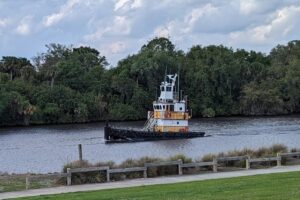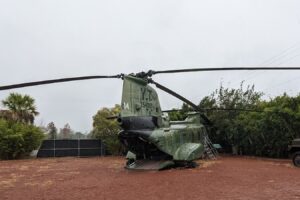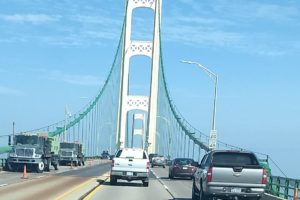Today Jekyll Island is a Georgia State Park, but before WWII, it was the vacation hot spot for the rich and famous. The day is cold and rainy, but we decided to explore as much as we could of this lovely island. We’re looking forward to coming back when it’s warmer so we can stay at the campground and walk or bike around the middle of the island to see the lovely houses.

We spent the morning walking through the museum with the history of the island (we’ll share what we learned in a future post), and then decided it was time for lunch. The docent recommended the Club Wharf that dates back to the heyday of the island.



The wharf was a perfect location of members to gather and socialize when they came to the island or to say goodbye after a pleasant winter season. From when the island opened for guests in 1886 until it closed in 1942, the only way to come to the island was by boat to this wharf. Access was only granted to members, member’ guests, and employees of the Jekyll Island Club.



the hotel


Horton House
As we drove north on the western side of the island, we came across this historic house that holds such an important place in the island’s history.



Horton cleared fields here for cultivating crops that supplied settlers at Frederica on St. Simons Island, a neighboring island, saving them from starvation. He then cut a road across the north end of the island, running east and west so he and his family could easily get to the beach.
Poulain du Bignon, owner of Jekyll Island after the Revolutionary War, repaired the Horton tabby house and made it his home. As his family grew, he added wooden wings to the house.
So what is tabby?

The lime that was used in tabby was made by burning oyster shells taken from Indian shell mounds, the trash piles of the local Indians. The word tabby is African in origin with an Arabic background; it means “a wall made of earth or masonry.” Spaniards brought this method of building to America.
When the coquina (shell rock) quarries near St. Augustine were opened, hewn stone superseded tabby for wall construction there. Since coastal Georgia doesn’t have coquina, tabby continued to be used here as late as the 1890s.


a home to last

As we’ve said, William Horton worked and lived on the island until he died in Savannah in 1748. While he made numerous improvements to the land, many haven’t lasted and the remains are hidden by the sandy soil. He completed his tabby home in 1743.
It was actually his 2nd home on the island. The first one was a wooden structure that had been burned by Spanish troops in 1742 after their defeat on St. Simons Island at the Blood Marsh (remember reading about this when we are at Fort King George?).

A lovely balcony was off the back of the house. From there, William and Rebecca could see their flourishing homestead that included a fine kitchen garden, barns, malt-house, brew-house, and overseer’s home.


Horton was expected to bring 10 indentured servants with him, 1 for every 50 acres; also, 20% of this granted land had to be in cultivation within 10 years of him coming to the new colony.
When Horton first arrived on Jekyll Island it was virtually isolated. He was the first European to occupy the land and was responsible for the first sustainable farm.

At this fort, Horton became a major in the British Army and 2nd in command of the settlement under General Oglethorpe. It was here at Fort Frederica that the southern most frontier of the British colony was defended in an attack by the Spanish in 1742 (Battle of Bloody Marsh). This tactical win by the English military ensured that British rule was firmly established in Georgia.
preservation
In 1898, members of the Jekyll Island Club realized the importance of this building and began stabilizing it. They rebuilt the north wall and recoated the building with stucco.
Did you notice the orange look to the building? It’s because of the preservation work done in 2002 when the stucco was reapplied to the structure (stucco was historically used in all tabby buildings). In this application, as in the original application, local sand was used, giving the building the orange look. As it ages, it will bleach out and become a paler, creamy color.

As we drove around the north end of the island, we got to see the campground. It looked pretty nice, and daily fees were reasonable since this is a state park. We’re looking forward to coming back when the weather is warmer so we can see more of the island only available by foot!
the beach
On the east side of the island were the beaches along the Atlantic Ocean. Even with the wind and rain, we just had to stop.



By mid-afternoon, the weather was cold and rainy, so we decided to check out the sea turtle restoration center that we’ll show you in the next post.




